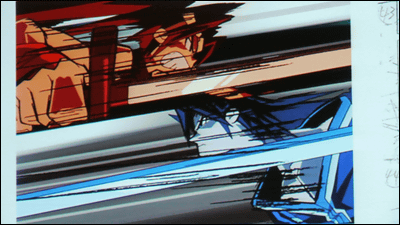Animators Toshiyuki Inoue and Ryo Imamura talk about the anime film 'Her Memories' in a talk session, with Toshiyuki Inoue discussing his work as a character animation director and 'shadow casting'

On Sunday, August 11, 2024, the first day of
Anime Fantasista Japan 2024
https://anime-fantasista-japan.jp/
The talk session lasted for an hour, and the discussion was very intense. Below is a rough summary of the content. It is divided by speaker, but it does not mean that each speaker spoke exactly as they said it.
From left: moderator Koji Takase, Ryo Imamura, and Toshiyuki Inoue.
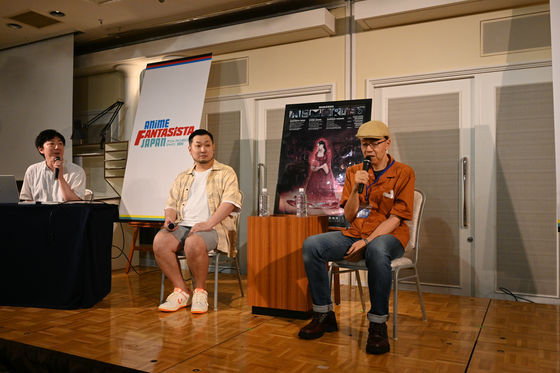
Moderator Koji Takase (hereinafter, Takase):
The story begins with 'Her Memories,' a chapter in the first theatrical production 'MEMORIES' by Studio 4℃ in Musashino City. Inoue is unusually in charge of character design and animation direction for this work.
Toshiyuki Inoue (hereinafter, Inoue):
Certainly, I've been an animator for over 40 years, but I wonder how many times I've been a character animation director... I actually did 'Gu-Gu Ganmo' and this 'MEMORIES' with Masaki Kajishima, and also the educational film 'The Day the Air Disappears.' I was a character animation director on 'Palm Tree,' but I didn't do character design. I often help out as a character animation director, but the only time I've done both is on 'MEMORIES.'
Takase:
In that way, I think it's a work that Mr. Inoue also has a special attachment to.
Inoue:
As a result, it became a work that I have a lot of attachment to. I reluctantly took on the character design, but in the end, I ended up being the animation director as well. I made 'Her Memories' first, then 'Cannon Town', and then I had a little more time, and I think it was released around the same time as 'Ghost in the Shell'. I also did 'Ghost in the Shell', but I remember doing the character design for 'Memories' around the time of the Olympics. I also remember working on it when Mori Mamoru went into space (Editor's note: Mori's space shuttle mission took place from September 12th to 20th, 1992). When I had to depict zero gravity, I remember seeing Mori on the space station and being prepared. Zero gravity is something that I have avoided even in science fiction anime, and I was thinking about how to cover up the zero gravity scene until I saw Mori, but when I saw that, I thought I couldn't escape, so I tried to draw it seriously.
Takase:
It's interesting to see how it reflects the social phenomena of the time.
Inoue:
It might be more accurate to say that when I saw it, I wanted to draw it.
Takase:
On the other hand, Imamura-san was born in 1986. How did you come to see 'Her Memories'?
Ryo Imamura (hereinafter, Imamura):
When I first entered the anime industry, MAD animation was very popular. I became interested in various people, and although the works I saw were good, I wanted to dig deeper, so I made 'Her Memories' and 'Construction Stop Order'...
Inoue:
Did you not see that at the cinema, but on video or something?
Imamura:
Yes, that's right.
Takase:
You've said that 'Her Memories' is one of your favorite works, but what was it about it that appealed to you?
Imamura:
It's a one-of-a-kind piece that allows you to enjoy nearly 40 minutes of rare artwork directed by Inoue, so that alone makes it worth watching.
Takase:
So, Inoue's style really comes through.
Inoue:
At that time, when the animation production was nearing the end, if the animation director couldn't make the corrections in time, or if there were things that the animation director couldn't fix, the assistant animation director would fix them. It wasn't in the credits, but that was normal. I've helped out in various ways, but at the time, the cuts that came to the assistant animation director were very problematic in terms of both the pictures and the content. That's what my experience up until 'MEMORIES' was like, so I thought that 'the animation director is the one who redraws the key animation,' and when the key animation was piled up in front of me, I would often redraw anything that I wasn't satisfied with in any way. If that happened, I knew that if I were the animation director, I would have to redraw it myself, and I couldn't say that I could do it, so I continued to refuse to be the animation director.

Inoue:
I ended up taking on the role of 'MEMORIES' because I was persuaded to 'gather skilled people who don't need to be corrected,' and I was told I would only have to show off my skills as a key animator. In reality, all of the planned members didn't come together. I think the reason my influence is so strong is because in the end, I ended up correcting 60-70% of the work, going beyond the normal level of corrections to the key animation. Even though they gathered some promising young people, I was pretty ruthless in my corrections, so at the time they may have thought I was a 'bastard.' But if I had been in a different position, my key animation would have been redrawn, so I guess that's past the statute of limitations.
Takase:
Among all of this, what was it that specifically attracted you?
Inoue:
I think Imamura-kun doesn't know how it was made back then, so he'll probably guess based on the way animation directors do it today. I was once asked by young animator Masami Mori, 'Who drew this scene in 'MEMORIES'?' and I had trouble answering that question. Of course there was a key animator, but I made all the corrections myself... I told Mori-kun, a promising young animator, the process and how it ended up looking like my key animation. If it was done the way it is now, a professional would be able to tell, 'This is a correction by the animation director, but the key animator's touch is still there in this area,' but I think there are parts of 'MEMORIES' where the key animator doesn't show through.
Imamura:
I understand what you mean, Okiura-san.
Inoue:
For Hiroyuki Okiura, I only fixed his face, and completely ignored his proportions, acting style, and timing. I think the ones who will be able to see through are Koichi Arai and Okiura.
Takase:
However, Mr. Okiura said, 'My part looked out of place, so I wanted it fixed.'
Inoue:
Did you say that? I've been told something similar to that, but I wonder if it's the truth...?
(Audience laughs)
Takase:
Once again, what was it about the screenplay that attracted you?
Imamura:
You can see Inoue's elegant paintings all the time. The three-dimensional effect and precise shading on top of his superb drawing skills. It's not the 'pattern shading' that was popular at the time, but precise shading on the edges. I wondered if it was in the style of Nakamura Takashi or something.
Inoue:
I personally think that Nakamura's style doesn't come out in 'MEMORIES,' but it was a transitional period at the time. The shadowing of 80s-style animation, seen in Madhouse's heyday in 'Kamui no Ken,' 'Genma Taisen,' 'Time and Space Traveler,' and 'Labyrinth Story,' was a thick shadowing that didn't follow the three-dimensionality of the clothes, making the picture look gorgeous and increasing the density. But I thought there must be a better way. Then 'Long Live the Ancestors!' came along, and Utsunomiya Osamu was the first to realize an ideal, three-dimensional picture that was just right for movement.
Takase:
'Long Live the Ancestors!' was released between 1989 and 1990, so it was just before 'MEMORIES.'
Inoue:
I came across “Long Live Our Ancestors!” just before making “MEMORIES” and was convinced that it was the ideal form of cell look, and although I don’t think I put it into words, you could say that this experience led me to make “MEMORIES.”
Imamura:
Mr. Inoue, you had recently participated in 'Run Melos', so what did you think of Mr. Okiura's design?
Inoue:
'Melos' also had a direct influence on the work. The character sheet for 'MEMORIES' is on display, so I hope you'll take a look, and I think the influence is strong. I think watching 'Osenzoku-sama' and studying 'Melos' was put to good use in 'MEMORIES.' But I don't think 'Melos' was influenced by 'Osenzoku-sama.' 'Osenzoku-sama' is a work full of originality that could be said to be the first or second, but perhaps the influence had not yet been fully digested.
Takase:
Sorry to interrupt you on Mr. Imamura's talk about 'good taste.'
Inoue:
That's right (laughs). I think I understand that somehow. The kind of drawing I admire is not refined, but rather... I know it's harsh to say it, but the more vulgar it is, the more impact it has when it becomes a cel. Ohira Shinya's drawings are unique, and I myself have always admired that kind of thing, because I'm not satisfied with my own individuality and I feel like I can't break out of my shell. I think that 'MEMORIES' is a work that has come to fruition in a good way, but I'm not satisfied with the part of it that is called 'refined'. I've been wanting to draw in a way that I think is amazing, like being reborn, and 40 years have passed without me being able to break out of my shell, and I feel like my life is about to end, and I wonder if I'll be able to break out of my shell before I die.
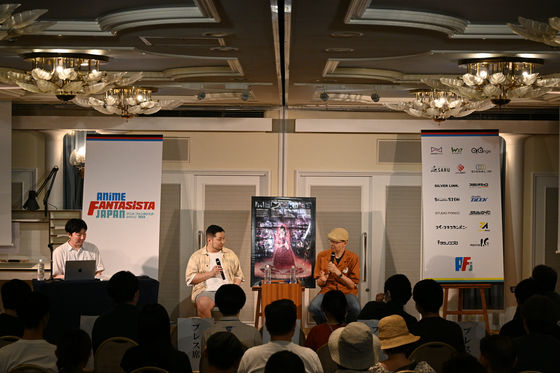
(Audience laughs)
Inoue:
I have a dream that if I can get the image to become half blurred, I might be able to create more unruly drawings.
Takase:
Do you think that kind of refinement is something we should aim for?
Inoue:
But the artwork I like and the artwork I want to draw are a little different, aren't they? There are some people who have the same preferences, but for me, there's a slight difference, and I really have a lot of preferences, and I think, 'This is great!' I think the same is true for Imamura-kun.
Imamura:
Yes. My opinion of Mr. Inoue is that he absolutely hates to lose.
Inoue:
Yes, I definitely hate losing (laughs). But I also think I'm the kind of person who can accept defeat. Even as I raise the white flag, I wonder if there's a way to get revenge.
Imamura:
I personally think that it is this history of struggle that makes Inoue the perfect animator.
Inoue:
I hate losing, but I'm also aware of my losses, so I'm an analytical person. But I think Imamura-kun has similar qualities. I first became aware of Imamura-kun when he contributed illustrations to the 'Children of the Sea' book, and although it may sound strange to say this in front of him, I was shocked. I had no idea there was such a talented person.
Imamura:
Oh.
Inoue:
I've seen a lot of talented people, but I've never been shocked by anyone. ...On the Internet, there are a lot of people who shock people across borders, and recently I've been looking at the Internet every day, declaring defeat, and feeling depressed.
(Audience laughs)
Inoue:
However, I am not particularly impressed by Japanese animators, and I think that may be because I hate to lose, but when I saw Imamura's illustrations, I thought, 'I may not be able to compete.' I think that many animators are good at drawing, but many of them cannot draw pictures with artistic sense. I can draw the original animation drawings, but I cannot draw good pictures. I don't have the drawing ability, or the artistic talent...
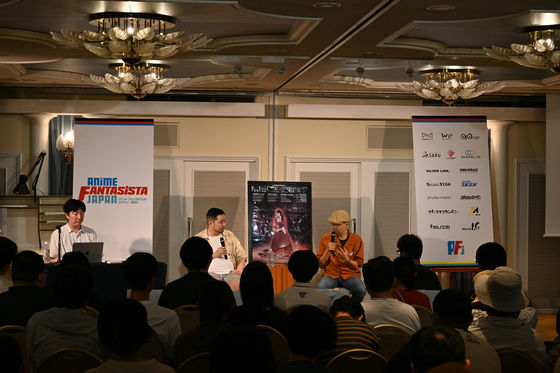
Imamura:
It's like whether you can draw a picture.
Inoue:
I don't have much drawing ability, and I'm the kind of person who wouldn't draw if I wasn't working on anime. Looking at it, I think that many animators are the same. Among them, I felt that Imamura-kun has artistic talent. You can tell at a glance that he has done a lot of research and drawn it, and that he is trying to capture the structure of the female body. 'Big Brother is Over!' honestly expresses the desires of the artist... is it okay to broadcast it?
(Audience laughs)
Inoue:
I praise it for being good and wonderful. The title of the work I put up on X, which may seem problematic in short, was also well timed.
Imamura:
The official title is 'Even the Student Council Has Holes!' (laughs)
Inoue:
I really like the way it's done in four frames, with no in-between frames intentionally. I like four frames too. Overseas, fewer frames are preferred, and the master Richard Williams is a 1-frame supremacist, so I couldn't say to him, 'This was made in three frames.' In recent years, there has been an increase in Japanese-style productions, but until about 10 years ago, people overseas would say, 'If it's three frames, it looks jagged.' I like that jagged look.
Imamura:
It makes the viewer fill in the gaps. While the image is flying in four frames, it seems to me that the viewer is not simply seeing the in-between frames, but is filling in the gaps by imagining other original frames.
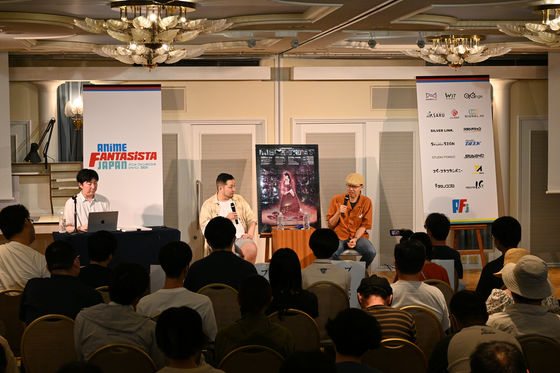
Takase:
In Richard Williams' case, there is no complementation.
Inoue:
Because he draws it himself. But because single-frame footage is just smoothly connected, there is no space between the lines, and it seems like a text full of boring explanations. It would have been more interesting if the reader had imagined between the lines. It is common for something to be lost and become boring by adding in-between frames. Takahata Isao once said, 'The original drawings were so lively, but when you add animation, it's lost.' He said that he had a rich imagination, but by explaining it with simple in-between frames, the brilliance of the original drawings was lost. Returning to the topic, the PV for 'Seitokai mo ana wa aru!' is a four-frame film, so good pictures remain for four frames, which makes it easier to remember. Imamura-kun's skillful drawings are more memorable than two-frame films, and the movement in between is complemented, so I watched it thinking, 'This guy knows what he's doing.' The new one was also wonderful, with a series of beautiful pictures.
Imamura:
thank you.
Takase:
Mr. Inoue, do you think that your high evaluation of Mr. Imamura is due largely to the power of his artwork?
Inoue:
I don't think people are calling it web-based anymore, but there are people who have started drawing digitally. They place the utmost importance on movement and don't place much importance on the quality of each drawing. The drawings in the middle of the movement are hardly recognized, so even if you put effort into it, it's the type of thing.
Takase:
I think the style that people who were headhunted online and started drawing original illustrations had in common was ultimately called web-style. It was around the late 2000s to early 2010s.
Inoue:
I grew up in a different era, so I can't imitate the web genre, but there are some commonalities. And the generation that came after them has a similar mindset to the web genre, but also values movement.
Imamura:
There's

Inoue:
Now that people who surpass the web have come along, I look at the internet and think, 'Our era is over.' I had a conversation with Mori Masami on Sakuga Yutai, and he described my drawings as 'mother's cooking.' Mother's cooking is inferior in taste and quality to that of a traditional Japanese restaurant, but when asked which he prefers, he would say, 'Mom's meat and potatoes.' It's important that you grew up with it, and I think for Imamura, 'MEMORIES' is like mother's cooking. If you think about it objectively, I think today's high-quality anime is better (laughs).
Imamura:
To me, it still tastes like high-class cuisine.
Inoue:
'MEMORIES' was my youth as an animator, and the experience of the 80s came to fruition in a good way, which may have led to such evaluation. I've come to think that I want to put into words what my ideal anime is, what I should aim for in the future (laughs), and I think that the quality of animation has been amazing recently, and although it's amazing, I wonder how it will turn out as commercial animation. I think it's beyond the limits of what can be made. It's good for anime to have passion, but I feel that there is too much information and passion. As a commercial anime, I think there is something just right about the look and drawing method. A work I've seen recently is 'Bakeneko Anzu-chan,' which is the opposite, and I liked how it was made in a less detailed direction.
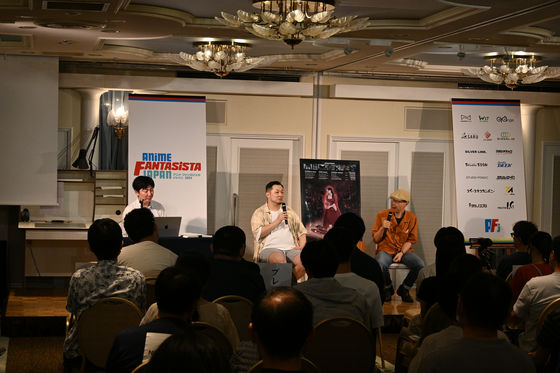
Imamura:
I do think it would be better if there was more variation in the animation. Although detailed illustrations are fine in certain places, I think it would be better if there was more variation between each cut.
Inoue:
Although it would be okay to leave out more information when drawing a long shot, the same information is still included as in the close-up shot... The parts that move around a lot are more like a web, and I think it's fine as long as you can distinguish the different colors.
Imamura:
I think it would be good to do more of these. One I've seen recently is 'Look Back.'
Inoue:
Director Oshiyama will be coming later, but I think there was a competitive spirit in 'Look Back'. Nowadays you can add as much light and effects as you want, but 'Look Back' is so simple that nothing is added, and the characters are just on the background. Gradations can be easily blurred digitally, but the colors are painted so cleanly that I think, 'Maybe it could be blurred a bit more?'
Imamura:
That honesty is good.
Inoue:
The videos are also popular online, and no one points out that the pictures don't have an additive effect. 'Anzu-chan,' 'Look Back,' and 'Long Way North' are so clean that they don't even blur the background. They're really amazing. If you're confident in your drawings, and if you have the skills of Imamura-kun, I think you could compete with just a bare background. So I hope that after I die, you'll lead the industry in that direction (laughs).
(Audience laughs)
After the hour-long talk, Inoue and Imamura held a book signing session.

Furthermore, Imamura said, 'If you come for the second round, they'll add a picture,' so the line got long, so he moved to another location to continue the autograph session.
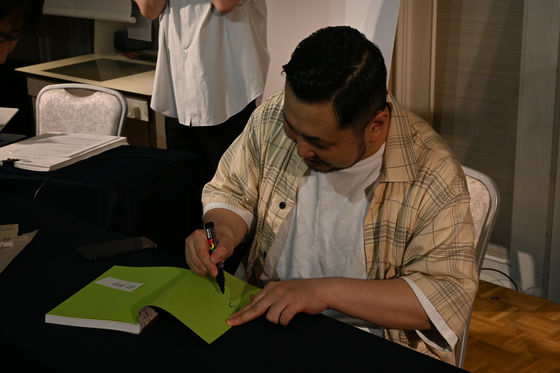
You can hear more details at ANIME FANTASISTA JAPAN, so be sure to check it out.
By the way, Mr. Inoue pointed out some shortcomings in my summary.
Although there are some slight differences in nuance, the overall article is compact. However, I would like to make a slight correction to the latter part of the article, which refers to the web genre. I believe I said, 'Those who have come to prominence since the web genre have inherited the ideas of the web genre, but also tend to value drawing.' https://t.co/3oRmnI2v2S
— Toshiyuki Inoue (@181ino) August 12, 2024
Related Posts:



